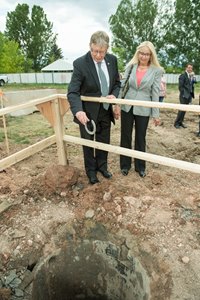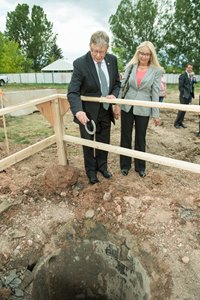Sales Radiology Study Progresses, Looking for Funding


The large Thoroughbred sales radiology study led by Colorado State University's Orthopaedic Research Center veterinarians, Drs. Wayne McIlwraith, Frances Peat, and Chris Kawcak; and Dr. Jeff Berk from Lexington, has gained widespread support as it continues its successful run.
This study investigates two of the most often discussed controversial issues at sales by buyers, sellers, and veterinarians alike: radiographic findings in the proximal sesamoid bones of the fetlock, with associated suspensory branch changes; and radiographic findings in the medial femoral condyle of the stifle.
The study commenced at the 2016 Keeneland September yearling sale, and continued through the 2-year-old sales in 2017. Researchers were able to follow 78% of all eligible 2-year-olds that had consignor permission for radiographic inclusion in the study as yearlings because of a great understanding within the industry for the need of this research.
Studies of this size require considerable funding. Three major industry organizations recognized the need for the research and its potential to positively impact the Thoroughbred industry, as it seeks to uncover critically sought-after information regarding the significance of sesamoiditis and stifle lesions. The Keeneland Association has committed $100,000 toward the successful completion of this work. Fasig-Tipton has made a $50,000 commitment toward the research. The Grayson-Jockey Club Research Foundation has approved a grant application submitted by the researchers for an additional $143,624.
Researchers are now in the final phase of collecting funding contributions from private donors who believe in the value of this study and are in a position to support it financially.
Since repositories were introduced to Thoroughbred auction houses in the 1990s, a degree of uniformity in radiology has developed, particularly for OCD lesions. However, some radiographic changes remain a persistent source of controversy for sellers, buyers, trainers, and veterinarians. That is why sesamoiditis and lucencies, or subchondral cystic lesions (SCLs) of the medial femoral condyle, are the focus of this study.
The first phase of the study was conducted at the 2016 Keeneland September yearling sale with excellent collaboration from the sales company and consignors. Consignors presenting yearlings at this sale were asked permission to include the yearlings in the radiographic and/or ultrasonographic portions of this study.
Radiographic permission was granted by 71 consignors, resulting in a total of 2,795 yearlings, or 74% of all yearlings presented for sale that had radiographs available. Of these yearlings, suspensory branch ultrasonography on 704 horses was performed on farms before they shipped to Keeneland. The radiographs have been evaluated for changes in the sesamoid bones and the medial femoral condyles of the stifles. The ultrasound images will be evaluated for abnormalities involving the suspensory ligament branches at their insertion onto the sesamoid bones.
The second phase of this project followed horses that had radiographs included in the study as Keeneland September yearlings, to five of the major 2-year-old sales in 2017: the Fasig-Tipton Gulfstream sale, Ocala Breeders' Sales March sale, OBS Spring sale, Fasig-Tipton Midlantic sale, and OBS June sale. Permission for inclusion in the second phase of the study was granted by 45 2-year-old consignors, for 78% of eligible horses. This amounted to 473 2-year-olds on which to evaluate radiographs and 415 of these horses also had suspensory branch ultrasounds performed for the study prior to the under tack shows. Researchers will again evaluate the sesamoid bone/suspensory branch complex and the radiographic stifle lucencies in this group of horses.
The third phase of the project will follow the racing performance of these horses, culminating at the end of their 3-year-old year. Paired radiographs and ultrasound images will enable the progression, regression, or static nature of certain radiographic and ultrasonographic findings to be studied, under the conditions in which these sale horses are managed.
"This study is badly needed," said Berk, whose equine veterinary career exclusively involves sales work. "Critical decisions have to be made at the sale that affect both consignors and potential buyers that preclude sales of horses when the decision is sometimes based on no evidence of a given lesion leading to unsoundness."
"Modern medicine decisions are supposed to be based on evidence, and these two problems are excellent examples of decisions being made without adequate data," McIlwraith said. "No evidence-based work has been published that pairs yearling and 2-year-old sale radiographs for individual horses."
This study will be the largest of its kind and will yield information that will be extremely useful to those involved in the selection process of sales horses. It will aid veterinarians in providing their buying and selling clients with a more accurate assessment of the significance of these findings. It will also help those in the Thoroughbred industry gain an understanding that not all radiographic findings are contributory factors to any given horse's suitability for racing. With the cooperation of the sales companies, consignors, owners, and veterinarians, this study has gained great traction. All those involved in the sales process stand to benefit from this much needed, and now highly anticipated, information.
With contributions totals at $293,624, substantial cost savings in the second year of the study have enabled a reduction in the overall budget to $425,000 for completion of the research. The researchers are now looking to individuals, farms or organizations, who believe in the importance of this research and are in a position to support it financially, to contribute to the remaining $135,000 required for the study.
Donations in the region of $5,000 from 25 individuals, farms or organizations would complete the researchers' fund-raising efforts. Parties interested in making a contribution to the study through Colorado State University may contact wayne.mcilwraith@colostate.edu.
